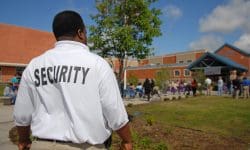UMass Amherst Solves the ‘Blarney Blowout’
A year after an annual event known as Blarney Blowout caused national headlines for its chaos, the University of Massachusetts Amherst hosted an orderly, largely peaceful event by changing its approach.

The University of Massachusetts Amherst has had problems with student partying in the past, but school administrators and campus police wanted to make sure 2015's Blarney Blowout was different.
The Day Arrives
“We didn’t know what we were going to wake up to on March 8,” Gelaye says. “We did a significant amount of planning, put in a lot of effort, but we didn’t know what was going to happen. We just knew we transformed our thinking and approach, and we were one step closer to finding the solution.”
Aside from the town ceasing to acknowledge the Blarney Blowout event in 2015, the school banned visitors from staying in residence halls. There were also parts of the campus deemed off limits by police. Students woke up on March 7 to find a significantly increased police presence equipped with paddy wagons and surveillance cameras. Officers were happy to answer student questions about what activities were and weren’t permitted.
Popular musical artists Juicy J. and Ke were slated to perform a four-hour, free outdoor concert for anyone who was interested. A trained student team titled Team Positive Presence spread the word to their peers that the concert was a responsible way to enjoy the day.
Students noticed the difference right away.
“It was definitely better than last year, the fact that police were omnipresent kept the idea in the back of people’s minds not to go crazy like last year,” senior Robert Galvin says. “I also think they were more permissive to an extent. It was definitely better violence-wise.”
Efforts Lead to a Successful Turnaround
Only six arrests were made on the day of March 7, 2015. Pictures of police talking with students replaced last year’s images of police arresting them.
“We were clear about our expectations, and students were very clear about their expectations,” Gelaye says. “When we encountered them on the ground that day, they wanted to be treated respectfully.”
“I talked with a few of them,” senior Bobby Babcock says of police. “They were definitely friendlier and more laid back. It didn’t stop people from doing their thing. They were effective just with their presence and no crazy tactics.” While Babcock says he was uncomfortable with what he thought was excessive supervision, he acknowledges that police did a good job preventing the “mob mentality from forming” among students.
Gelaye says many of their tactics worked exactly how school officials had planned. The concert attracted around 1,000 students.
“We created a safe space for students to gather and be compelled,” Gelaye says. “That changed the environment dramatically.”
The use of social media allowed officials to get immediate feedback from students about
what techniques were working and what techniques weren’t.
Gelaye Offers Advice to Other Campuses
Gelaye says a major part of the school’s success was accepting blame for problems in years past.
“It started with just owning up to it, admitting that this was a campus-wide problem,” she says. “And understanding that the solution wasn’t going to be single-office specific, but rather it’s going to have to be a campus and a town working together to fix this.”
When asked for advice, Gelaye emphasizes the importance of introspection.
“I would tell other schools to step back and reflect on what’s worked in your community and what hasn’t,” Gelaye says. “When you need an external, unbiased eye, bring in a consultant like we did. If you can’t do that, learn from other schools. The Davis Report is available online for anyone to look at. There are a lot of good recommendations out there, it’s just about finding the ones that work for your campus.”
Judging by the drastic change in the March 7 event from 2014 to 2015, it appears the university did just that.
Zach Winn is the associate web editor of Campus Safety Magazine
If you appreciated this article and want to receive more valuable industry content like this, click here to sign up for our FREE digital newsletters!
 Leading in Turbulent Times: Effective Campus Public Safety Leadership for the 21st Century
Leading in Turbulent Times: Effective Campus Public Safety Leadership for the 21st Century
This new webcast will discuss how campus public safety leaders can effectively incorporate Clery Act, Title IX, customer service, “helicopter” parents, emergency notification, town-gown relationships, brand management, Greek Life, student recruitment, faculty, and more into their roles and develop the necessary skills to successfully lead their departments. Register today to attend this free webcast!













